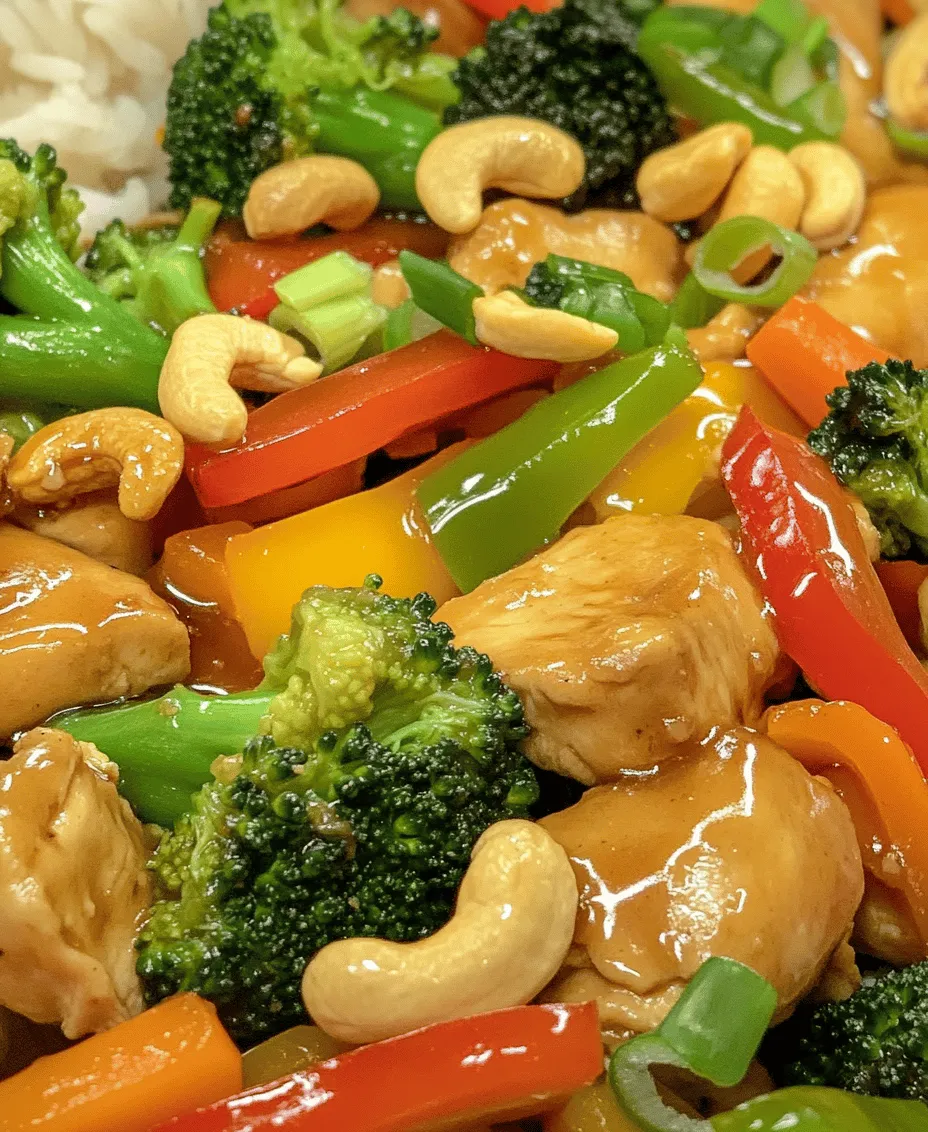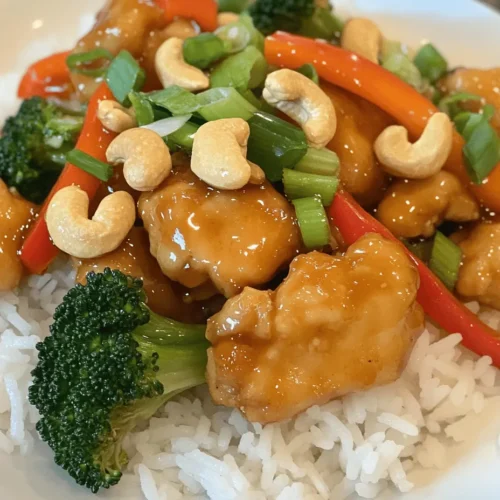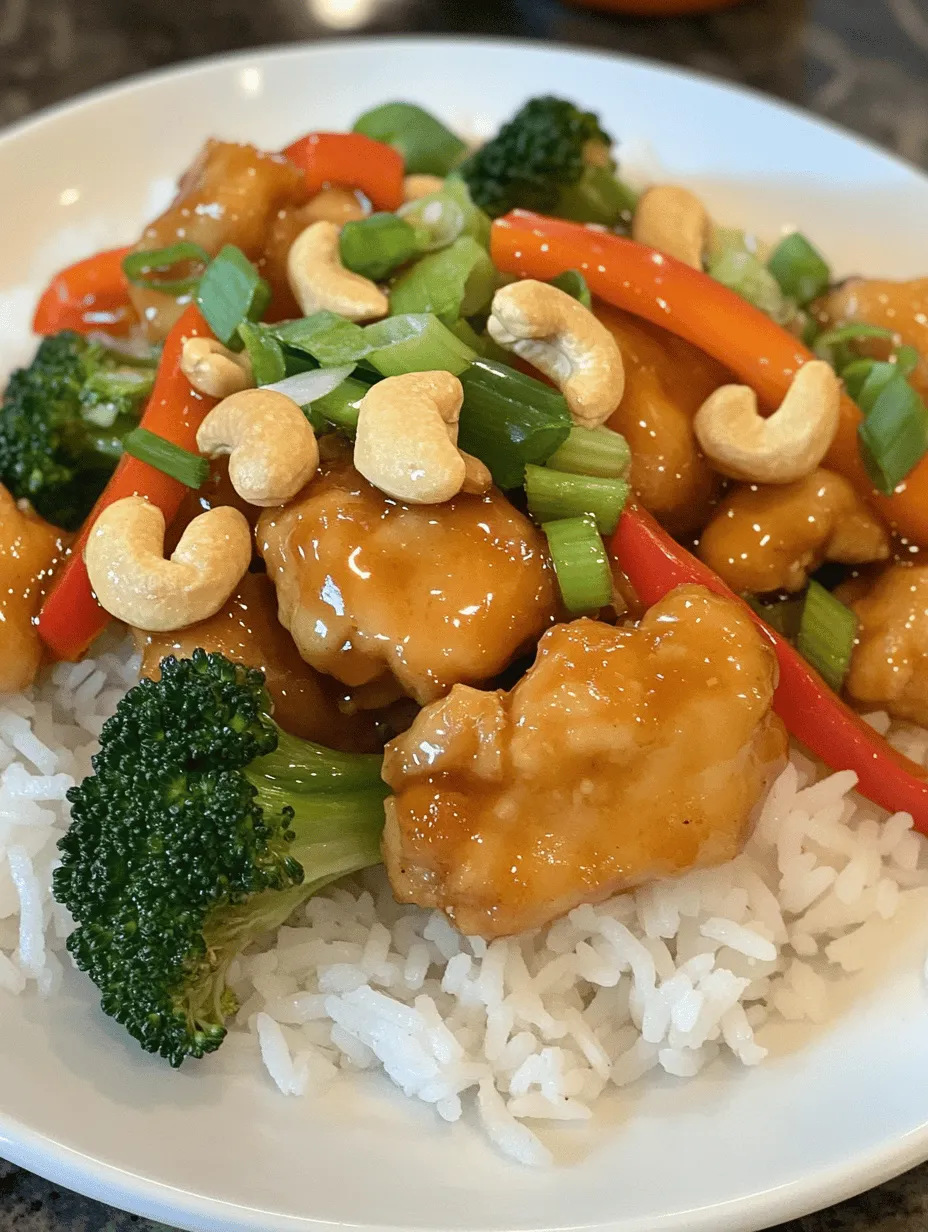Introduction
In the world of quick and satisfying meals, few dishes rival the allure of takeout. The convenience of ordering in after a long day is tempting, but what if I told you that creating a better-than-takeout experience in your own kitchen is not only possible but also incredibly rewarding? This Better-Than-Takeout Cashew Chicken recipe is your ticket to a delightful culinary adventure that will transport your taste buds straight to your favorite Asian restaurant.
Imagine tender chicken, vibrant vegetables, and the irresistible crunch of roasted cashews all coming together in a delicious stir-fry that’s not only simple to prepare but also a healthier alternative to traditional takeout. The beauty of making Cashew Chicken at home lies not just in the taste but also in the ability to customize the dish according to your preferences. Whether you prefer it spicy or mild, packed with veggies or loaded with cashews, this recipe allows you to take control of your meal and enjoy a nutritious dish that doesn’t skimp on flavor.
Let’s dive into the essential components of this dish and uncover the secrets that make it so special.
Understanding the Ingredients
Exploring the Essential Components of Cashew Chicken
To create a truly exceptional Cashew Chicken, understanding the ingredients is paramount. Each component plays a vital role in achieving the ideal balance of flavor and texture. Here’s a closer look at the key ingredients:
Chicken Breast: The Foundation of Flavor
The star of our dish is undoubtedly the chicken breast. Opting for lean chicken breast not only provides a healthy protein source but also absorbs the flavors of the marinade beautifully, resulting in tender, juicy bites. When selecting chicken, look for pieces that are plump and have a pink hue, avoiding any that appear dull or have an unpleasant smell.
For the best results, cut the chicken into even bite-sized pieces. This ensures uniform cooking and allows the marinade to penetrate the meat thoroughly.
Cashews: The Crunchy Element
Cashews bring a delightful crunch and nutty flavor that elevates the dish. Not only do they add texture, but they also provide healthy fats and protein, making your meal more satisfying. When shopping for cashews, choose raw or roasted unsalted varieties. If you prefer a touch of sweetness, roasted and salted cashews can also work well, adding an additional layer of flavor.
For optimal freshness, store cashews in an airtight container in a cool, dry place. You can also toast them lightly in a skillet before adding them to the stir-fry for an enhanced flavor profile.
Vegetables: A Rainbow of Nutrition
Incorporating a variety of colorful vegetables not only enhances the dish’s visual appeal but also boosts its nutritional value. Fresh vegetables like bell peppers, broccoli, and snap peas not only add crunch and flavor but also provide essential vitamins and minerals. Aim for a mix of textures and colors to create a more vibrant and nutritious meal.
When choosing vegetables, consider seasonal options for the best flavor and price. Fresh organic produce is ideal, but frozen vegetables can also be a convenient alternative.
Sauces: The Secret to Flavorful Marinades
The magic of Cashew Chicken largely lies in the sauces used to create a rich, savory marinade. A combination of soy sauce, oyster sauce, and sesame oil provides a perfect balance of umami flavors. This blend creates a delicious coating that enhances the chicken and vegetables.
For those looking for gluten-free options, tamari can be used instead of regular soy sauce, while vegetarian oyster sauce is available for a meat-free version of the dish.
Oil: The Key to Perfect Stir-Frying
Stir-frying requires high-temperature cooking, which means that the choice of oil is crucial. Use oils with a high smoke point, such as vegetable oil, peanut oil, or grapeseed oil, to achieve that perfect sear on your chicken and vegetables. These oils not only withstand high heat but also add their unique flavor to the dish.
Preparing Your Ingredients
Tips for Selecting and Prepping Fresh Ingredients
Now that we’ve explored the essential ingredients, let’s take a closer look at how to select and prepare them for cooking.
Choosing the Right Chicken
When purchasing chicken, freshness is key. Look for chicken that is bright pink and has no unpleasant odor. If possible, buy organic or free-range chicken for a more humane and flavorful option. Additionally, consider purchasing chicken from a local butcher for the freshest cuts.
Before cooking, ensure that you rinse the chicken under cold water and pat it dry with paper towels. This step helps remove any residual bacteria and ensures a better sear when it hits the pan.
Selecting Fresh Vegetables
For the best taste and nutrition, always choose fresh, seasonal vegetables. When shopping, look for crisp, vibrant produce without any signs of wilting or browning. Bell peppers should be firm, broccoli should have tight florets, and snap peas should snap easily when bent.
To prepare the vegetables, wash them thoroughly under cool running water. Cut them into uniform pieces for even cooking. For instance, slice bell peppers into strips, chop broccoli into bite-sized florets, and trim the ends off the snap peas.
The Importance of Quality Cashews
As mentioned earlier, the quality of your cashews can significantly impact the dish. Opt for unsalted or lightly salted cashews for the best flavor. If you want to enhance their crunchiness, toast them in a dry pan over medium heat for a few minutes until they are golden brown.
Make sure to let the cashews cool before adding them to your dish to maintain their texture.
Preparing Aromatics: Garlic and Ginger
Garlic and ginger are essential aromatics that provide a depth of flavor in Cashew Chicken. Use fresh garlic and ginger for the best results—these ingredients are readily available in most grocery stores and provide a more vibrant taste compared to their powdered counterparts.
To prepare garlic, simply peel the cloves and mince them finely. For ginger, use a peeler to remove the skin, then grate or finely chop it. These aromatics will be sautéed at the beginning of the cooking process to release their flavor, ensuring that your dish is aromatic and fragrant.
Creating the Marinade
Step-by-Step Guide to a Flavorful Marinade
Now that we have our ingredients ready, it’s time to create a flavorful marinade that will infuse the chicken with incredible taste.
Combining Ingredients for Maximum Flavor
In a mixing bowl, combine the following ingredients for the marinade:
– 3 tablespoons soy sauce
– 1 tablespoon oyster sauce
– 1 tablespoon sesame oil
– 1 tablespoon rice vinegar (optional for added acidity)
– 1 tablespoon of cornstarch
Whisk these ingredients together until smooth. The cornstarch serves two purposes: it helps the chicken absorb the flavors and creates a silky texture as it cooks.
The Role of Cornstarch in Marinating
Cornstarch is a secret weapon in many stir-fry dishes. Not only does it help to thicken the sauce, but it also creates a protective coating around the chicken, preventing it from drying out during cooking. This results in a tender, juicy texture that elevates your dish above typical takeout.
Start by adding the chicken pieces to the marinade, ensuring that each piece is fully coated. Cover the bowl with plastic wrap or transfer it to a resealable plastic bag, then let it marinate in the refrigerator for at least 30 minutes. For the best flavor, aim for 1-2 hours of marinating time.
How Long to Marinate Chicken for Best Results
While a quick 30-minute marination can work in a pinch, allowing the chicken to marinate for a longer period—up to a few hours or even overnight—will result in a more flavorful dish. The chicken will absorb the marinade, enhancing the overall taste and tenderness.
As you prepare the rest of your ingredients, keep the marinating chicken in the fridge. This ensures that the flavors meld together while you work on the vegetables and other components of the dish.
By following these steps, you’ll be well on your way to creating a delicious Better-Than-Takeout Cashew Chicken that will impress both family and friends. In the next part of this article, we will explore the cooking process in detail, ensuring that every element comes together perfectly for a delightful homemade meal. Stay tuned for the exciting conclusion of this culinary journey!

Cooking Techniques for Perfect Cashew Chicken
Mastering the stir-fry method is essential to achieve that restaurant-quality Better-Than-Takeout Cashew Chicken. Stir-frying is a quick cooking technique that preserves the freshness and crunchiness of ingredients while enhancing the flavors. Here’s how to master this technique for the perfect dish.
The Importance of High Heat
One of the cornerstones of successful stir-frying is high heat. When using a wok or a large skillet, ensure your cooking surface is properly preheated before adding any ingredients. The goal is to achieve a sear on the chicken and vegetables, which locks in moisture and flavor.
1. Preheat Your Pan: Heat your wok or pan over medium-high heat until it’s hot. A drop of water should sizzle and evaporate almost immediately upon contact with the surface.
2. Use the Right Oil: Opt for oils with high smoke points, like vegetable or peanut oil, to avoid burning. This allows you to cook at higher temperatures without affecting the flavor of your dish.
Timing: Cooking Chicken to Perfection
Timing is crucial when cooking chicken in a stir-fry. Overcooked chicken can become dry and tough, while undercooked chicken can pose health risks.
1. Cut Uniformly: Dice the chicken into bite-sized pieces, ensuring they are uniform in size for even cooking.
2. Cook in Batches: If your wok is crowded, the chicken will steam instead of sear. Cook it in two or three batches if necessary to achieve that beautiful golden brown color. Each batch should take about 3-4 minutes to cook through.
3. Check for Doneness: Always use a meat thermometer to check that the internal temperature of the chicken reaches 165°F (75°C).
Stir-Frying Vegetables: Achieving the Right Texture
Vegetables are the heart of this dish, adding both flavor and color. The key is to cook them quickly while retaining their crunch.
1. Add in Stages: Start with sturdier vegetables like bell peppers and carrots, as they require longer cooking times. After a couple of minutes, add in softer vegetables like snap peas and broccoli for the last minute or two.
2. Color and Flavor: The contrast in colors not only makes the dish visually appealing but also provides a variety of textures. Aim for a vibrant mixture to enhance both taste and presentation.
Bringing it All Together
Now that you’ve mastered the cooking techniques, it’s time to combine all your ingredients for maximum flavor.
Reintroducing the Chicken
After the vegetables are perfectly cooked, it’s time to bring back the chicken to the mix.
1. Combine: Add the cooked chicken back into the wok with the sautéed vegetables. This allows the chicken to absorb some of the flavors from the veggies and the sauce you’ll be adding shortly.
2. Toss to Combine: Use a spatula to gently toss the chicken and vegetables together, ensuring everything is evenly distributed.
Thickening the Sauce: Cooking Tips
The sauce is what makes this dish truly special. Here’s how to achieve the perfect consistency.
1. Add Sauce Gradually: Pour your prepared sauce mixture over the chicken and vegetables evenly. Stir continuously to coat all ingredients uniformly.
2. Simmer for Thickness: Allow the mixture to simmer for a few minutes. This will help the sauce thicken due to the cornstarch, creating that glossy finish typical of takeout dishes. If you desire a thicker sauce, mix a teaspoon of cornstarch with a tablespoon of water and add it while stirring the dish.
Folding in the Cashews for Crunch
Cashews are the star ingredient that brings texture and richness to your dish.
1. Add Cashews Last: Fold in the cashews gently after the sauce has thickened to prevent them from becoming too soft. This will add that delightful crunch that contrasts with the tender chicken and vegetables.
2. Toss Again: Give everything a final stir to ensure the cashews are coated with the sauce and warm throughout.
Serving Suggestions
To elevate your Cashew Chicken experience, consider the following serving suggestions.
Choosing the Right Base: Rice vs. Noodles
The choice of base can significantly enhance your dish.
1. White Rice: A classic option that absorbs the flavors perfectly. Use jasmine or basmati rice for an aromatic experience.
2. Brown Rice: For a healthier option, brown rice adds a nutty flavor and extra fiber.
3. Noodles: If you prefer noodles, opt for lo mein or rice noodles. They can soak up the sauce beautifully and provide a satisfying chew.
Garnishing for Visual Appeal and Flavor
A well-garnished dish makes for a more enjoyable dining experience.
1. Green Onions: Chopped green onions sprinkled on top add a fresh, sharp contrast to the richness of the dish.
2. Sesame Seeds: Toasted sesame seeds not only provide an appealing look but also enhance the flavor profile with their nutty aroma.
Pairing with Side Dishes for a Complete Meal
Enhance your meal by pairing Cashew Chicken with complementary side dishes.
1. Spring Rolls: Crispy vegetable spring rolls can add a delightful crunch and balance the meal.
2. Stir-Fried Greens: Simple stir-fried bok choy or spinach with garlic adds a healthy and colorful side.
3. Soup: A light miso or wonton soup as a starter can round off the meal beautifully.
Nutritional Benefits of Cashew Chicken
This dish is not just delicious; it also carries several nutritional benefits.
Protein-Packed Chicken
Chicken is an excellent source of lean protein, essential for muscle growth and repair. It provides the necessary amino acids required for overall body function.
1. Low in Fat: By using skinless chicken breast, you can keep the dish low in saturated fat while still enjoying a hearty meal.
Nutritional Powerhouse: Vegetables
The combination of colorful vegetables in this recipe contributes to a wide array of vitamins and minerals.
1. Antioxidants: Vegetables like bell peppers and broccoli are rich in antioxidants, which help fight inflammation and boost your immune system.
2. Fiber: Many of the included vegetables are high in fiber, aiding digestion and promoting gut health.
The Heart-Healthy Benefits of Cashews
Cashews are not only delicious but also packed with nutrients.
1. Healthy Fats: Cashews contain monounsaturated fats, which are heart-healthy and can help lower bad cholesterol levels.
2. Vitamins and Minerals: They are a good source of magnesium, zinc, and iron, contributing to overall health and wellness.
Conclusion
Creating Better-Than-Takeout Cashew Chicken at home is not just about enjoying a delicious meal; it’s also about embracing healthier choices and the joy of cooking. With a few simple ingredients and techniques, you can delight your family and friends with a dish that rivals any restaurant offering. This recipe not only satisfies cravings but also encourages a deeper connection with the food we eat. Embrace the flavors and the cooking process, and enjoy this delightful dish as a staple in your home cooking repertoire.
By mastering the art of stir-frying and incorporating fresh ingredients, you’ll find that homemade Cashew Chicken is not only enjoyable to make but also a fulfilling and nutritious meal option. So gather your ingredients, unleash your culinary creativity, and savor the experience of creating this restaurant-quality dish in your own kitchen.



